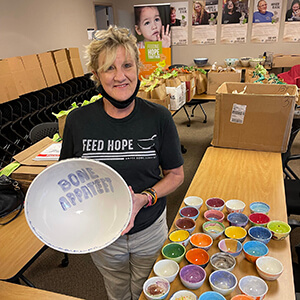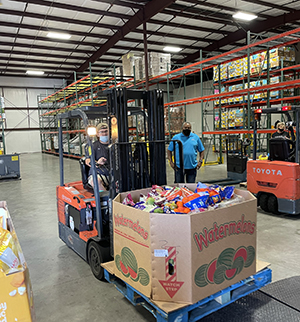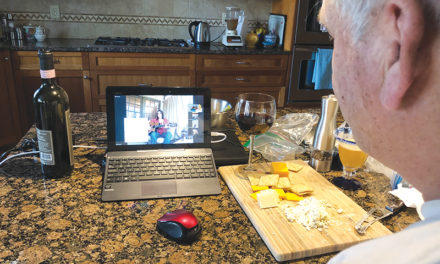
Executive Director Kay Blackstock displays colorful bowls for the Empty Bowl Luncheon plus one of the “celebrity bowls” that was auctioned at the event. This bowl was Jeff Foxworthy’s “Bone Appateet!”
For some, it might be unthinkable that people in Georgia are going hungry, especially children. Unfortunately, it’s an everyday reality for thousands. In the pandemic, food insecurity became a reality across the United States, with long lines at food distribution facilities that communicated through social media and news channels.
“The truth is that hunger was a reality long before the pandemic, but it was often hidden,” said Kay Blackstock, founder and executive director of the Georgia Mountain Food Bank. “The face of hunger could be a co-worker, a store clerk, a neighbor, or a total stranger you see in everyday life.”
A number of years ago, Blackstock worked in a building that shared space with a food bank.
“I knew about the food pantry, but I didn’t expect to see a well-dressed woman come in and then leave with a bag of food,” she said. “It wasn’t that she was well dressed. I just knew her to be from a family that shouldn’t need food assistance. I assumed she was there to visit the ballet, symphony or junior league office.
“People make assumptions and judgments about people without knowing the full story,” she said. “In truth, we never know what another person might be struggling with.”
The Georgia Mountain Food Bank evolved as a project of the North Georgia Community Foundation. Community meetings were organized and leadership was brought together. By November 2007, the Georgia Mountain Food Bank was incorporated in Georgia. Organizers also formed a partnership with the Atlanta Community Food Bank at the same time. That relationship is still in place today.
Food sources and destinations
Today, the organization, with a staff of nearly a dozen, plus an army of volunteers, distributes more than 300,000 pounds of groceries and household items each month, from dried goods and staples to meats and fresh produce to 68 partner agencies in five counties, food pantries operated by churches, senior centers, treatment and recovery centers, and on school grounds.
The Georgia Mountain Food Bank also operates mobile food pantries to take food directly to people in communities across north Georgia. Plus, two refrigerated box trucks are on the road five days a week, picking up food from area retailers and bringing it to the 22,000-square-foot warehouse for sorting.
Sorted food is then redistributed to the 68 partner agencies and used to supply the mobile food pantries that are often open in the evenings or weekends at area school campuses, extended-stay hotels or shopping centers.
“We couldn’t do what we do without our amazing volunteers,” Blackstock says. “Even during the pandemic, many of our volunteers, even those considered high-risk, continued to help.”
For almost nine months during the pandemic, Georgia’s Governor Brian Kemp brought in members of the Georgia Defense Force and the Georgia National Guard, making it possible for the organization to continue to operate during the time of greatest need.

Warehouse Supervisor Alec Tipton moves a box of food items as Operations Director Charles Johnson looks on.
“Georgia Mountain Food Bank is unique here among other food banks in Georgia because so much of our inventory relies on donations from the retail market,” Blackstock said. “These donations are brought back to our facility, where they are sorted, inspected and weighed and entered into inventory.”
The process continues with partner agencies receiving a weekly inventory email. Each partner orders the amount of food they need to serve their clients. Direct delivery is an option, while others pick up at the GMFB facility at 1642 Calvary Industrial Drive SW in Gainesville.
“GMFB receives regular shipments of grocery salvage and other resources through its partnership with the Atlanta Community Food Bank,” she said. “There are eight Feeding America member food banks in Georgia and most are part of the Georgia Food Bank Association, under the excellent leadership of Executive Director Danah Craft.”
It takes a village
It may sound trite, but it takes a village to operate effective food bank distribution centers, plus the network of food pantries and mobile distribution programs.
And the processes and procedures are monitored and audited.
“We have an annual financial audit and a complete operational audit every two years,” Blackstock said. “And we’re regulated for health and safety regarding food donations, handling and distribution. Food rescue of prepared foods from restaurants and catering events is strictly regulated. These foods must be kept at certain temperatures; any donations are documented and logged.
“Our food bank does accept donations of fresh foods, mostly produce and some dairy in date and frozen meats,” she said. “All fresh food must be distributed quickly.”
Each September, GMFB hosts its Empty Bowl Luncheon. It’s the group’s only fund-raising event and last year funds from the luncheon provided more than 830,000 meals to people struggling with hunger in Hall, Lumpkin, Union, Forsyth and Dawson counties.
This year’s virtual event, attended by nearly 1,000, raised $245,065 – enough to provide more than 1.22 million meals. Organizers exceeded their goal by 225,000 meals. The live auction alone raised enough funds to provide 134,250 meals.
“We also rely on financial donations from individuals, businesses and corporations to accomplish our work,” Blackstock said. “Although this fundraiser takes place once a year, hunger happens every day, so we rely on the community to support our mission all year long.”
Just one paycheck away
For many Americans, the loss of one paycheck or the occurrence of one catastrophic event could lead to hunger and even homelessness.
“From personal experience years ago, as a single mother of three children, there were times when I had to make difficult choices,” Blackstock said. “My children never experienced food insecurity and many of the negative consequences because of choosing to buy groceries or have a utility bill unmet.
“So many people helped us and at the time I questioned my ability to return all that was given to us. I believe that working with Georgia Mountain Food Bank is my way of returning the favor given to our family.
Ways you can help
“Tell the story of the Georgia Mountain Food Bank, share the outreach and encourage legislators to advocate for programs that help families in need,” she said. “Make a financial gift: every $1 donated equals five meals. Donate your time.”
To volunteer, contact volunteer@gamountainfoodbank.org. To donate or to learn more, visit www.gamountainfoodbank.org or call 770 534-4111.
The Georgia Mountain Food Bank distributes an average of 300,000 pounds of food monthly, averaging 30,000 people. Approximately 60 percent of the food collected by the food bank comes from retail partners, such as Publix, Walmart, Kroger, Aldi’s, Sam’s, Tyson, Performance Food Service, and Sprouts Farmers Markets. 40 percent of the food purchased or grown in America is thrown away because of overserving, overbuying, spoilage or waste. That equals 108 billion pounds of food annually that goes in the garbage, an annual value of $161 billion. For every $1 donated to the organization, the Georgia Mountain Food Bank can provide five meals. More than 90 percent of every dollar donated goes directly to the organization’s programs and mission. At least one person in approximately 70 percent of families who depend on a food bank for regular meals works full time.
*Sources: Feeding America Network, Georgia Food Bank Association.







